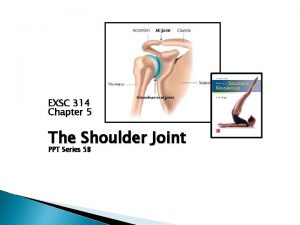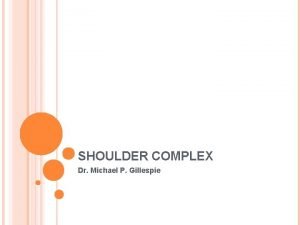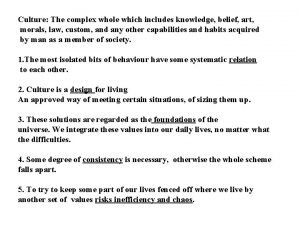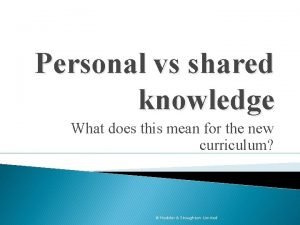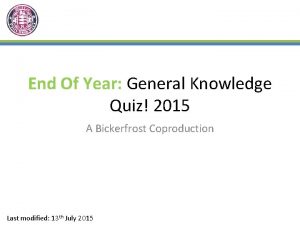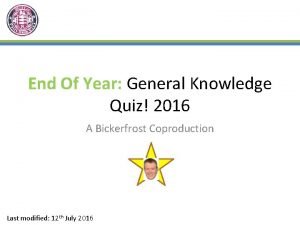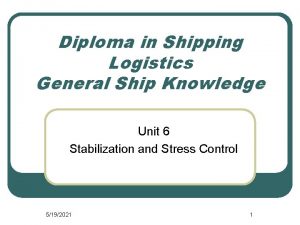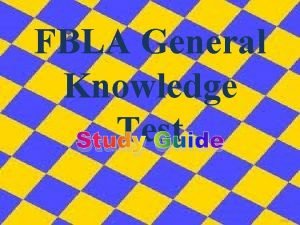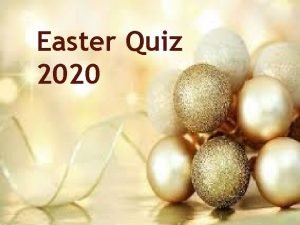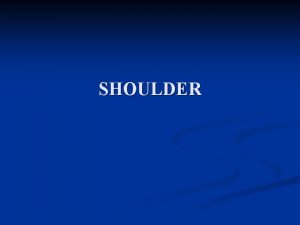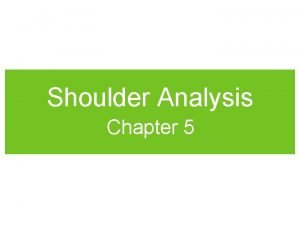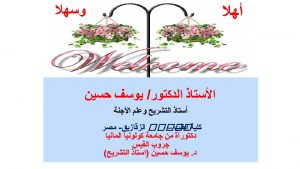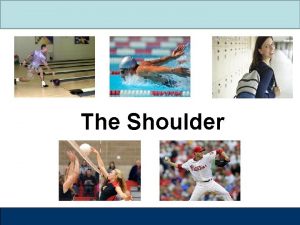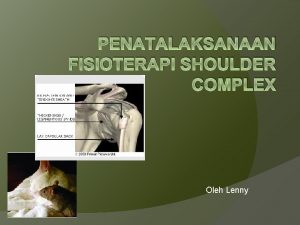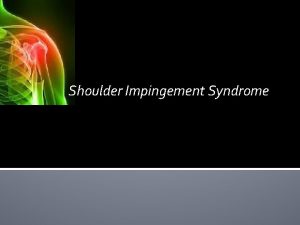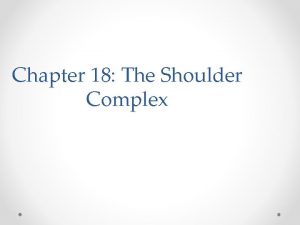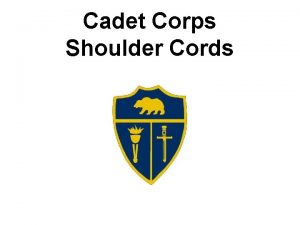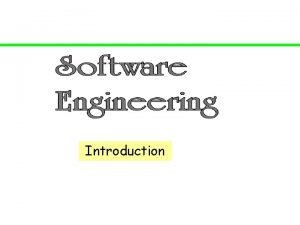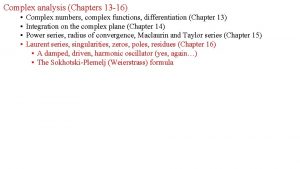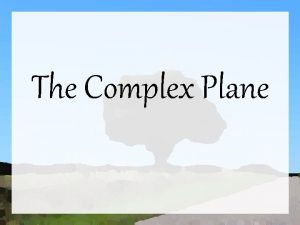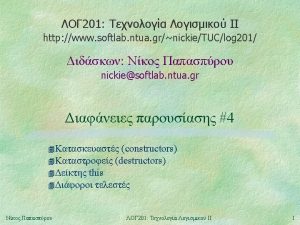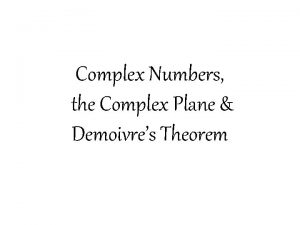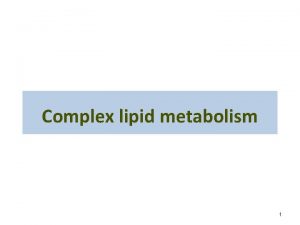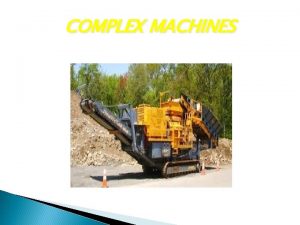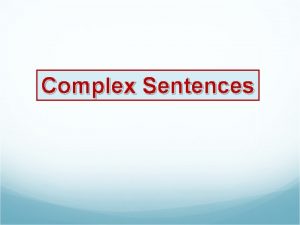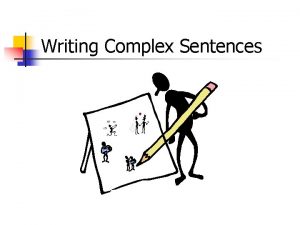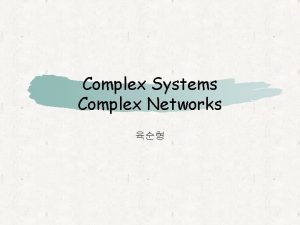The Shoulder Complex General Knowledge The shoulder is
















































- Slides: 48

The Shoulder Complex

General Knowledge �The shoulder is an extremely complicated region of the body �Greater mobility = Greater Instability �Involved in a variety of overhead activities susceptible to a number of repetitive and overused injuries �Movement and stabilization of the shoulder requires the cooperation of: Rotator cuff muscles � Joint capsule � Scapula stabilizing muscles � © 2007 Mc. Graw-Hill Higher Education. All rights reserved.

General Knowledge 3 Main Joints Glenohumeral Joint = humerus and scapula Sternoclavicular Joint (SC) = Sternum and clavicle Acromioclavicular Joint (AC)= Acromion and distal clavicle Labrum cartilage that lines the glenoid fossa providing support and protection to the humeral heal (similar to the meniscus) http: //www. virtualmedicalcentre. com/videopage. as p? vidid=849 © 2007 Mc. Graw-Hill Higher Education. All rights reserved.

Basic Anatomy © 2007 Mc. Graw-Hill Higher Education. All rights reserved.

Anatomy © 2007 Mc. Graw-Hill Higher Education. All rights reserved.

Anatomy © 2007 Mc. Graw-Hill Higher Education. All rights reserved.

Muscular Anatomy © 2007 Mc. Graw-Hill Higher Education. All rights reserved.

Muscular Anatomy © 2007 Mc. Graw-Hill Higher Education. All rights reserved.

Muscular Anatomy © 2007 Mc. Graw-Hill Higher Education. All rights reserved.

Movements http: //www. youtube. com/watch? v=FHq 3 K 6 J 3 Wq 8 http: //www. youtube. com/watch? v=RPRJPNCVRd. E © 2007 Mc. Graw-Hill Higher Education. All rights reserved.

Prevention of Shoulder Injuries Proper physical conditioning is key Develop body relative to sport – Sport Specific Strengthen through a full ROM Focus on rotator cuff muscles in all planes of motion Be sure to incorporate scapula stabilizing muscles Foundation for the function of the glenohumeral joint © 2007 Mc. Graw-Hill Higher Education. All rights reserved.

Prevention of Shoulder Injuries Warm-up should be used before explosive arm movements – before practices and games Contact and collision athletes should receive proper instruction on how to fall Protective equipment Football, hockey, catchers, rugby Mechanics versus overuse injuries Muscular weakness or imbalance VS throwing 200 pitches everyday © 2007 Mc. Graw-Hill Higher Education. All rights reserved.

Throwing Mechanics Instruction in proper throwing mechanics is critical for injury prevention © 2007 Mc. Graw-Hill Higher Education. All rights reserved.

Throwing Mechanics Jennyi. Finch – Sport Science http: //www. youtube. com/watch? v=_de 3 HJv. O-N 8 Drew Brees – Sport Science http: //www. youtube. com/watch? v=t. Voq. A-LKGb 4 Pitching Biomechanics http: //www. youtube. com/watch? v=h 53 qlk. Hve. QA Pitching Tips http: //www. youtube. com/watch? v=qv. NMv. Oe. HUL 8 © 2007 Mc. Graw-Hill Higher Education. All rights reserved.

Throwing Mechanics Windup Phase First movement until ball leaves gloved hand Lead leg strides forward while both shoulders abduct, externally rotate and horizontally abduct Cocking Phase Hands separate (achieve max. external rotation) while lead foot comes in contact w/ ground Acceleration Max external rotation until ball release (humerus adducts, horizontally adducts and internally rotates) Scapula elevates and abducts and rotates upward © 2007 Mc. Graw-Hill Higher Education. All rights reserved.

Throwing Mechanics Deceleration Phase Ball release until max shoulder internal rotation Eccentric contraction of ext. rotators to decelerate humerus while rhomboids decelerate scapula Follow-Through Phase End of motion when athlete is in a balanced position © 2007 Mc. Graw-Hill Higher Education. All rights reserved.

Pitch Count Pitch counts should be monitored and regulated in youth baseball. Pitch count limits pertain to pitches thrown in games only. These limits do not include: throws from other positions instructional pitching during practice sessions throwing drills, which are important for the development of technique and strength. Backyard pitching practice after a pitched game is strongly discouraged. © 2007 Mc. Graw-Hill Higher Education. All rights reserved.

Pitch Count Recommended limits for 9 -10 year old pitchers: Recommended limits for 11 -12 year old pitchers: 50 pitches per game 75 pitches per week 1000 pitches per season 2000 pitches per year 75 pitches per game 100 pitches per week 1000 pitches per season 3000 pitches per year Recommended limits for 13 -14 year old pitchers: 75 pitches per game 125 pitches per week 1000 pitches per season 3000 pitches per year © 2007 Mc. Graw-Hill Higher Education. All rights reserved.

Assessment of the Shoulder Complex History What is the cause of pain? Mechanism of injury? Previous history? Location, duration and intensity of pain? Creptitus, numbness, distortion in temperature Weakness or fatigue? What provides relief? © 2007 Mc. Graw-Hill Higher Education. All rights reserved.

Assessment of the Shoulder Complex �Observation Elevation or depression of shoulder tips Position and shape of clavicle Acromion process Biceps and deltoid symmetry Postural assessment (kyphosis, lordosis, shoulders) Position of head and arms Scapular elevation and symmetry Scapular protraction or winging Muscle symmetry Scapulohumeral rhythm © 2007 Mc. Graw-Hill Higher Education. All rights reserved.

Assessment of the Shoulder Complex Palpation Bony structure palpation should occur on both shoulders at the same time Why? Palpate soft tissue structures for point tenderness, swelling, spasms, lumps, guarding or trigger points Be sure to palpate anteriorly and posteriorly © 2007 Mc. Graw-Hill Higher Education. All rights reserved.

Assessment of the Shoulder Complex Special Tests Active and Passive Range of Motion Flexion, extension Abduction and adduction Horizontal Abduction/Adduction Internal and external rotation Muscle Testing Specific muscles of the shoulder and scapula © 2007 Mc. Graw-Hill Higher Education. All rights reserved.

Apprehension test (Crank test) �Apprehension test used for anterior glenohumeral instability This motion should not be forced � Easier to have the athlete lay down © 2007 Mc. Graw-Hill Higher Education. All rights reserved.

Test for Shoulder Impingement Neer’s test and Hawkins-Kennedy test for impingement used to assess impingement of soft tissue structures Positive test is indicated by pain and grimace Neer’s Hawkins. Kennedy © 2007 Mc. Graw-Hill Higher Education. All rights reserved.

Test for Supraspinatus Weakness �Empty Can Test 90 degrees of shoulder flexion, internal rotation and 30 degrees of horizontal adduction Downward pressure is applied Weakness and pain are assessed bilaterally © 2007 Mc. Graw-Hill Higher Education. All rights reserved.

Clavicle and AC joint Compression Test Compress the clavicle and spine of the scapula together + if increased movement is felt or pain is experienced

Recognition and Management of Specific Injuries �Clavicular Fractures Cause of Injury � Fall on outstretched arm/hand (FOOSH) � Fall on tip of shoulder or direct impact � Occurs primarily in middle third � (greenstick fracture often occurs in young athletes) Signs of Injury � Generally presents supporting arm, head tilted towards injured side w/ chin turned away � Clavicle may appear lower or displaced � Palpation reveals pain, swelling, deformity and point tenderness © 2007 Mc. Graw-Hill Higher Education. All rights reserved.

Clavicle Fractures Care Immobilaize with sling ; Referral for X-Ray Possible Sx Occasionally requires operative management Closed reduction - sling and swathe, immobilize w/ figure 8 brace for 6 -8 weeks Removal of brace should be followed w/ joint mobes, isometrics and use of a sling for 3 -4 weeks © 2007 Mc. Graw-Hill Higher Education. All rights reserved.

Clavicle Fx © 2007 Mc. Graw-Hill Higher Education. All rights reserved.

�Fractures of the Humerus Cause of Injury � Humeral shaft fractures occur as a result of a direct blow, or fall on outstretched arm � Proximal fractures occur due to direct blow, dislocation, fall on outstretched arm Signs of Injury � Pain, swelling, point tenderness, � X-ray is positive for fracture decreased ROM Care � Immediate application of splint, treat for shock and refer � Athlete will be out of competition for 2 -6 months depending on location and severity of injury © 2007 Mc. Graw-Hill Higher Education. All rights reserved.

© 2007 Mc. Graw-Hill Higher Education. All rights reserved.

�Sternoclavicular (SC) Sprain Cause of Injury � Indirect force- FOOSH � blunt trauma (may cause displacement) Signs of Injury � Grade 1 - pain and slight disability � Grade 2 - pain, subluxation w/ deformity, swelling and point tenderness and decreased ROM � Grade 3 - gross deformity (dislocation), pain, swelling, decreased ROM Possibly life-threatening if dislocates posteriorly Care � PRICE, immobilization � Immobilize for 3 -5 weeks followed by graded reconditioning © 2007 Mc. Graw-Hill Higher Education. All rights reserved.

http: //www. youtu be. com/watch? v=f k. Gt. Nk. Bs. Xk. E

�Acromioclavicular Sprain Cause of Injury � Result of direct blow (from any direction), upward force from humerus, fall on outstretched arm Signs of Injury � Grade 1 - point tenderness and pain w/ movement; no disruption of AC joint � Grade 2 - tear or rupture of AC ligament, partial displacement of lateral end of clavicle; pain, point tenderness and decreased ROM (abduction/adduction) � Grade 3 - Rupture of AC and CC ligaments with dislocation of clavicle; gross deformity, pain, loss of function and instability © 2007 Mc. Graw-Hill Higher Education. All rights reserved.


AC Sprain © 2007 Mc. Graw-Hill Higher Education. All rights reserved.

Care Ice, stabilization, referral to physician Grades 1 -3 (non-operative) will require 3 -4 days (grade 1) and 2 weeks of immobilization ( grade 3) respectively Aggressive rehab is required w/ all grades Joint mobilizations, flexibility exercises, & strengthening should occur immediately Progress as athlete is able to tolerate w/out pain and swelling Padding and protection may be required until pain-free ROM returns © 2007 Mc. Graw-Hill Higher Education. All rights reserved.

© 2007 Mc. Graw-Hill Higher Education. All rights reserved.

Glenohumeral Dislocations Cause of Injury Head of humerus is forced out of the joint Anterior dislocation is the result of an anterior force on the shoulder, forced abduction, extension and external rotation Occasionally the dislocation will occur inferiorly Signs of Injury Flattened deltoid, prominent humeral head in axilla; arm carried in slight abduction and external rotation; moderate pain and disability Care RICE, immobilization and reduction by a physician Begin muscle re-conditioning ASAP Use of sling should continue for at least 1 week Progress to resistance exercises as pain allows © 2007 Mc. Graw-Hill Higher Education. All rights reserved.

http: //www. youtube. com/watch? v=-Hv 8 FM 78 I 7 I http: //www. youtube. com/watch? v=plquoz_m. Ki. Q © 2007 Mc. Graw-Hill Higher Education. All rights reserved.

Shoulder Dislocation © 2007 Mc. Graw-Hill Higher Education. All rights reserved.

Shoulder Impingement Syndrome Cause of Injury Mechanical compression of supraspinatus tendon, subacromial bursa and long head of biceps tendon due to decreased space under coracoacromial arch Seen in over head repetitive activities Signs of Injury Diffuse pain, pain on palpation of subacromial space Decreased strength of external rotators compared to internal rotators; tightness in posterior and inferior capsule Positive impingement and empty can tests © 2007 Mc. Graw-Hill Higher Education. All rights reserved.

Care Restore normal biomechanics in order to maintain space Strengthening of rotator cuff and scapula stabilizing muscles Stretching of posterior and inferior joint capsule Modify activity (control frequency and intensity) © 2007 Mc. Graw-Hill Higher Education. All rights reserved.

Rotator cuff tear Involves supraspinatus or rupture of other rotator cuff tendons Primary mechanism - acute trauma (high velocity rotation) Occurs near insertion on greater tuberosity Full thickness tears usually occur in those athletes w/ a long history of impingement or instability (generally does not occur in athlete under age 40) Signs of Injury Present with pain with muscle contraction Tenderness on palpation and loss of strength due to pain Loss of function, swelling With complete tear impingement and empty can test are positive © 2007 Mc. Graw-Hill Higher Education. All rights reserved.

Care RICE for modulation of pain Progressive strengthening of rotator cuff Reduce frequency and level of activity initially with a gradual and progressive increase in intensity © 2007 Mc. Graw-Hill Higher Education. All rights reserved.

Shoulder Bursitis Etiology Chronic inflammatory condition due to trauma or overuse subacromial bursa May develop from direct impact or fall on tip of shoulder Signs of Injury Pain w/ motion and tenderness during palpation in subacromial space; positive impingement tests Management Cold packs and NSAID’s to reduce inflammation Remove mechanisms precipitating condition Maintain full ROM to reduce chances of contractures and adhesions from forming © 2007 Mc. Graw-Hill Higher Education. All rights reserved.

Bicipital Tenosynovitis Cause of Injury Repetitive overhead athlete - ballistic activity that involves repeated stretching of biceps tendon causing irritation to the tendon and sheath Signs of Injury Tenderness over bicipital groove, swelling, crepitus due to inflammation Pain when performing overhead activities Care Rest and ice to treat inflammation NSAID’s Gradual program of strengthening and stretching © 2007 Mc. Graw-Hill Higher Education. All rights reserved.

Contusion of Upper Arm Cause of Injury Direct blow Repeated trauma could result in development of myositis ossificans Signs of Injury Pain and tenderness, increased warmth, discoloration and limited elbow flexion and extension Management RICE for at least 24 hours Provide protection to contused area to prevent repeated episodes that could cause myositis ossificans Maintain ROM © 2007 Mc. Graw-Hill Higher Education. All rights reserved.
 Hip joint ppt
Hip joint ppt Shoulder complex
Shoulder complex Simple compound complex and compound-complex sentences quiz
Simple compound complex and compound-complex sentences quiz Droplet infection
Droplet infection Simple, compound and complex sentences quiz
Simple, compound and complex sentences quiz Electra complex vs oedipus complex
Electra complex vs oedipus complex Psychodynamic theory of personality
Psychodynamic theory of personality Sublimation psychology
Sublimation psychology The complex whole which includes knowledge
The complex whole which includes knowledge That complex whole which includes knowledge
That complex whole which includes knowledge Shared knowledge vs personal knowledge
Shared knowledge vs personal knowledge Knowledge shared is knowledge squared
Knowledge shared is knowledge squared Knowledge shared is knowledge multiplied interpretation
Knowledge shared is knowledge multiplied interpretation Knowledge creation and knowledge architecture
Knowledge creation and knowledge architecture Contoh shallow knowledge dan deep knowledge
Contoh shallow knowledge dan deep knowledge Aposteriori
Aposteriori Street smart vs book smart
Street smart vs book smart Knowledge and knower
Knowledge and knower Gertler econ
Gertler econ General knowledge quiz 2015
General knowledge quiz 2015 General knowledge jeopardy
General knowledge jeopardy General knowledge quiz 2016
General knowledge quiz 2016 Easter general knowledge quiz
Easter general knowledge quiz General shipping knowledge
General shipping knowledge Usa general knowledge
Usa general knowledge Fbla political science study guide
Fbla political science study guide Easter quiz questions 2020
Easter quiz questions 2020 Planos en cinematografia
Planos en cinematografia Where did general lee surrender to general grant?
Where did general lee surrender to general grant? Hình ảnh bộ gõ cơ thể búng tay
Hình ảnh bộ gõ cơ thể búng tay Lp html
Lp html Bổ thể
Bổ thể Tỉ lệ cơ thể trẻ em
Tỉ lệ cơ thể trẻ em Chó sói
Chó sói Chụp tư thế worms-breton
Chụp tư thế worms-breton Bài hát chúa yêu trần thế alleluia
Bài hát chúa yêu trần thế alleluia Kể tên các môn thể thao
Kể tên các môn thể thao Thế nào là hệ số cao nhất
Thế nào là hệ số cao nhất Các châu lục và đại dương trên thế giới
Các châu lục và đại dương trên thế giới Công thức tính thế năng
Công thức tính thế năng Trời xanh đây là của chúng ta thể thơ
Trời xanh đây là của chúng ta thể thơ Mật thư tọa độ 5x5
Mật thư tọa độ 5x5 Làm thế nào để 102-1=99
Làm thế nào để 102-1=99 Phản ứng thế ankan
Phản ứng thế ankan Các châu lục và đại dương trên thế giới
Các châu lục và đại dương trên thế giới Thơ thất ngôn tứ tuyệt đường luật
Thơ thất ngôn tứ tuyệt đường luật Quá trình desamine hóa có thể tạo ra
Quá trình desamine hóa có thể tạo ra Một số thể thơ truyền thống
Một số thể thơ truyền thống Cái miệng nó xinh thế
Cái miệng nó xinh thế
